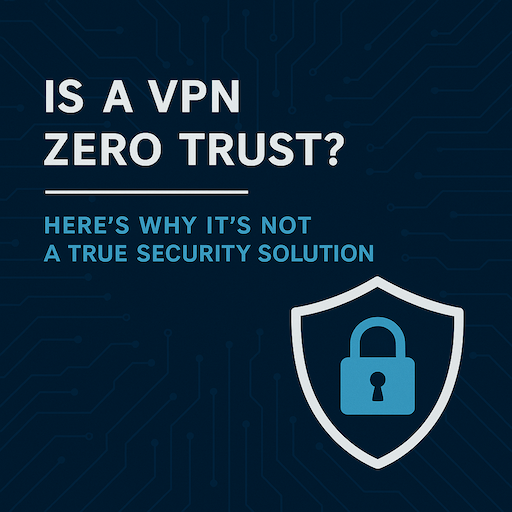Is a VPN zero trust?
Is a VPN Zero Trust? Absolutely not! In this short article, we explain why a VPN solution is not a true Zero Trust alternative. Don’t be misled by marketing hype—VPN software cannot deliver Zero Trust security, no matter what the vendors claim.
In a world of hybrid work, distributed teams, and increased reliance on cloud-based services, traditional perimeter-based security models like VPNs fall short. Businesses now require more than just a Virtual Private Network or VPN connection to safeguard remote access. Modern security architecture like Zero Trust architecture assumes no implicit trust, even from users or devices within the corporate network perimeter. This model ensures secure access for in-house and remote employees, remote users, and even external users—without exposing the entire network to potential risk. Example of external users are like contractors or guest users.

Understanding the Shift from VPN to Zero Trust
VPNs offer an encrypted tunnel into the private network through public internet, but once a connection is made, users often gain broad access to the corporate resources. That leads to expanded attack surfaces. In contrast, Zero Trust implements granular access control, enabling access to resources strictly on a need-to-know basis. That reduces the risk of lateral movement, unauthorized access, and insider threats.
Core Principles of Zero Trust
The Zero Trust security model is guided by several trust principles:
- Never trust, always verify: Every request is authenticated based on user identity, device security posture, and security policies.
- Least-privilege access: Access is granted only to necessary apps or data or even networks.
- Continuous verification: Ongoing checks using device identity, access controls, and threat detection.
- Granular control: Limits access to critical resources based on user roles, location, network, device posture, and behavior.
Addressing the Pitfalls of Legacy Security Models
Legacy security models, such as the castle-and-moat security approach, relied on a secure network perimeter—ideal in the age of corporate offices, but ineffective in today’s remote access solutions era. This approach creates potential attack vectors and increases security risk with the explosion of cloud services, mobile devices, and remote locations due to broad network access.
Zero Trust mitigates these challenges through strict access controls, trust architecture, and software-defined perimeters that prevent unauthorized access to network resources.
How Zero Trust Secures Remote Work
Organizations must adapt as more remote users access cloud-based services through the public internet. Zero Trust enables secure connections between remote employees and corporate networks without compromising performance or security posture. It replaces the centralized inspection of traditional VPNs with distributed policy enforcement that minimizes latency and enhances user experience.
Key Benefits Include:
- Secure access regardless of user location or device
- Reduced attack surfaces and better visibility into user activity
- Dynamic policy enforcement based on device health, risk profile, and real-time threat detection
- Elimination of complete access to the internal network, minimizing potential damage
Real-World Applications of Zero Trust
Organizations transitioning to Zero Trust enjoy robust access control across cloud-native apps, legacy technologies, and modern IT environments. It also simplifies audits and compliance with regulatory requirements and strengthens resilience against cyber threats and security breaches.
Trust network access replaces blind believes on a network connection only by evaluating security posture, device status, and user behavior at every interaction. For example:
- A remote user logging in from a coffee shop via a public internet connection undergoes multi-factor authentication and strict identity verification before gaining access to applications.
- Granular control ensures they only access specific files, not the entire network.
- Continuous monitoring prevents privilege escalation and lateral movement.
Implementing Zero Trust: Challenges and Considerations
Zero Trust is not plug-and-play. It involves:
- Assessing current security tools on the ground, network design and network infrastructures, and access management policies
- Mapping user roles, application access, and level of access
- Establishing a comprehensive protection framework using cloud security, Secure Access Service Edge (SASE), and Identity and Access Management (IAM)
Common challenges include implementation complexity, management complexity, and ensuring a seamless user experience. Fortunately, solutions such as Privileged Access Management (PAM), Access Control Lists, and Cloud Access Security Broker can support gradual rollouts with worry free security.
Why Zero Trust Is the Superior Choice
In an era of sophisticated cyberattacks, legacy security models can no longer protect corporate cybersecurity. Zero Trust architecture offers a modern cybersecurity strategy built for hybrid work environments, remote access technologies, and the dynamic nature of cloud-based services.
By adopting Zero Trust, businesses benefit from:
- Lower risk of security vulnerabilities and potential security risks
- Enhanced visibility and threat detection
- Comprehensive approach to security compliance and business continuity
In short, Zero Trust transforms how organizations approach network access, making it the most efficient solution for remote access security in today’s evolving cybersecurity environment.
How ThreatLocker Delivers True Zero Trust Security

Granular Access Control With Application Whitelisting
ThreatLocker enforces strict access controls by allowing only approved applications to run & execute, reducing attack surfaces and blocking unauthorized access at the endpoint level.
Ringfencing for Network-Level Protection
With Ringfencing™, ThreatLocker limits how applications interact with network resources, preventing lateral movement and securing corporate networks against internal and external threats.
Real-Time Control and Device Posture Enforcement
ThreatLocker empowers IT teams with real-time visibility and control over device security posture, ensuring that only trusted users and devices can access sensitive resources.
